The Hungarian Kingdom
To be formally recognized as a Christian king, one had to ask to be crowned by either the Pope or another king, but in this case he would be accepting him as his superior. Realizing this, István the first Christian king of Hungary in the year 1000 A.D., instead of asking to be crowned by the German emperor, asked Pope Sylvester II for a crown. On the 25th of December of that same year, István was crowned Hungary's Apostolic King. The Apostolic kings had special powers and privileges: the power to appoint bishops, regulate whether priests could marry or not, and so on. This power and privilege bestowed upon Hungarian kings signifies the power and the importance of the country in the eyes of the Roman Catholic Church. After his coronation, István began to lay down new laws to govern the country, and the strong foundation to the Roman Catholic Church in Hungary. During his rule he established ten church districts, two of which were archdioceses.
The brother-in-law of István, Emperor Heinrich II, died in 1024 and the good relationship between Hungary and the West came to an abrupt halt; in 1031, István was forced to defend the western border against Konrad II. In a fierce battle at the River Rába (by the city of Győr) the Hungarians, led by Prince Imre the son of István (who later became a Saint of the Roman Catholic Church), defeated the Germans. Unfortunately, shortly after the victory, Imre was assassinated. István selected his half-nephew, Péter Orseolo, to be his heir (Péter had lived in the King's Court since 1027). But the throne should have gone to Vászoly, István's cousin; a struggle for the throne was to ensue even before the King's death. In 1032, Vászoly was thrown in jail, his eyes put out while his sons were forced into exile. András and Levente escaped to Kiev; Béla fled to Poland. According to Kálti Márk's Képes (Illustrated) Chronicle, Saint István actually helped Vászoly's sons to escape. The German Knight, Vencelin was a force behind all of this, he may even have had a hand in the murder of Imre.
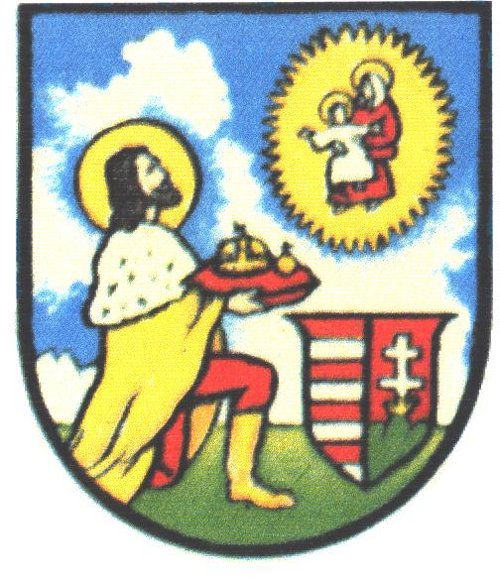
Coat of Arms of Fejér county: Saint István offers Hungary up for protection to Virgin Mary.
István died on August 15, 1038. Shortly before his death, he had offered Hungary up for protection to the Virgin Mary; noted for his good deeds on behalf of the Roman Catholic Church and for Christianity. The Church canonized him in 1083. István was posthumously proclaimed a Saint by the Roman Catholic Church. Péter followed István to the throne, but was chased out of the country in 1041. The dethroned King escaped to the German emperor, Heinrich III, who was pleased with the opportunity to come to his aid. In 1044, Heinrich defeated the Hungarian King, Aba Sámuel, and restored Péter to the Hungarian throne as his vassal. Due to internal strife, Hungary's enemies now succeeded in gaining the upper hand, something they could not have achieved on their own. Péter was dethroned for the second time in 1046, Hungary refusing to pay heavy taxes to the Emperor. Heinrich couldn't do a thing about it, demonstrating ever so clearly the economic and military might of Hungary at this time. The exiled princes – András, Levente and Béla – were called back and András was elected king. Yet, the situation did not stabilize completely because András continued to carry out the culturally detrimental policies of Géza and István. In 1055, he founded the Abby of Tihany. In the Latin text of the Foundation Deed there are some scattered Hungarian words. These are the oldest known Hungarian words that are written in Latin characters. The oldest known Hungarian text is the Halotti beszéd, which is a eulogy, found in a prayer book. It dates back to the XII Century. With the exception of a few words, it is understandable to modern Hungarians, which demonstrates the stability and the advanced development of the language. The strict laws and punishments of King László (1077-1095) – later declared "Saint" – finally ended all internal strife in the country. At this same time, Croatia became a province of Hungary under László’s rule; after the Croatian king had died, his wife, Ilona (László's sister), turned to her brother for help. László took charge of Croatia.
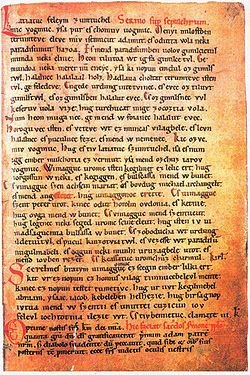
The Halotti beszéd (eulogy) is the oldest known Hungarian text.
László was followed to the throne by King Kálmán (1095-1116) the "Book Lover". He was probably the most learned king of his time. He decreed: "witches do not exist", and forbade the witch-hunts. He also relaxed cruel and unusual punishment for crimes that did not warrant it. Kálmán was a firm and wise ruler. He became the crowned King of Croatia and Dalmatia, the territory that later in that century was contested by Emperor Manuel of Byzantium. However, Manuel couldn’t achieve the desired success, so he had another plan to achieve his goal. Since he had no heirs, he offered the Byzantine throne to Béla, the younger brother of King István III of Hungary. Béla did go to Byzantium to live in the Court of the emperor; however, a son was born to Manuel and this subsequently led to the revocation of his offer to Béla. Béla (1172-1196) went on to become King of Hungary, yet was looked upon with some suspicion as he had adopted some of the Byzantine philosophies while away from home. Nevertheless, he succeeded in keeping Dalmatia under the Hungarian Crown during his rule.
Taxation and other excesses of government under the rule of King András II (1205-1235) created great dissatisfaction. The threat of revolution loomed. Donating large portions of land to his supporters backfired in the end as trouble continued to brew. The financially weakened King seemingly added fuel to an already perilous fire. In order to bring about calm and order, in 1222, András issued the Bill of Rights. Known as the Aranybulla (i.e., the Golden Bull, similar to the British Magna Carta document of 1215), the document unfortunately did not solve the problems that existed. András did not remove the government that was the cause of the dissatisfaction in the first place. The Aranybulla guaranteed significant rights to the nobility, including the right to revolt against the king if he overstepped the boundaries of his authority.
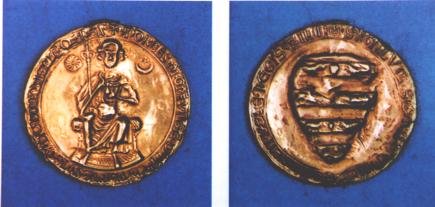
The Seal of the Aranybulla (Golden Bull)
After the death of András, his son inherited the throne as King Béla IV (1235-1270). His aim was to create a stable and powerful government and bring about respect for the throne. In order to do this, he took back the lands that had been given away by his father, levied new taxes, and made friends with no-one. Obviously, dissatisfaction became rampant throughout the country. At this time, in 1241, news came that the Mongolian Armies of Batu Khan were approaching Hungary. A large number of Kuns (Cumanians) along with their king, Kutten, fleeing from the advancing Mongolian Armies, were given permission to settle in Hungary. Béla hoped that they would be of great help in the upcoming struggle. King Béla called the country to arms, but the enraged and uncooperative aristocracy either did not respond or came up with conditions. One of their demands was that the King turn over Kutten to the Mongols. Batu sent his envoys to Béla with the same demand. The King's enemies murdered the envoys, an unforgivable crime. They also murdered Kutten, resulting in his warriors turning on the Hungarians in revenge; consequently most of them fled the country. Béla suffered a crushing defeat from the Mongols at Muhi (eastern Hungary), barely escaping capture; meanwhile, Béla's wife and the King's treasury fell into the hands of Prince Friedrich II of Austria. In order to regain the freedom of his wife, the treasury had to be forfeited, along with three western counties while Friedrich joined the Mongols to loot and rampage. The Mongols were cruel and merciless, not surprisingly, avenging their murdered envoys. From Zagreb, the fleeing King Béla turned to the Pope, the French king, and the German emperor for help; his requests were turned down. In the spring of 1442, the Mongols left Hungary and the King returned to begin the rebuilding of the country.
The last male in the direct line of the Árpád Dynasty, King András III died in 1301. The grandchild of the daughter of King István V, Robert Károly, was elected to the throne in 1308. Robert Károly was to become one of the greatest kings of Hungary. His wise economic and foreign policy made the country rich again and it regained its old glory and respect. His son, Lajos "The Great" (1342-1382), inherited a rich and powerful country. Lajos was a peaceful and courageous man, but he did not have his father's leadership qualities. His restless and ego-driven mother was the force behind many of his decisions to wage war. Lajos expanded the borders of his kingdom to the farthest that they would ever reach. He ruled over Poland, Moldavia, Galicia, Wallachia, Bulgaria, Serbia, Bosnia and Naples; this is why the title "The Great" was bestowed upon him. In the meantime, Turkish armies were approaching from the south and reaching the borders of the Hungarian Kingdom in 1373. After the death of Lajos his two daughters, Hedvig and Mária, inherited the throne. Hedvig became the Queen of Poland, Mária of Hungary.
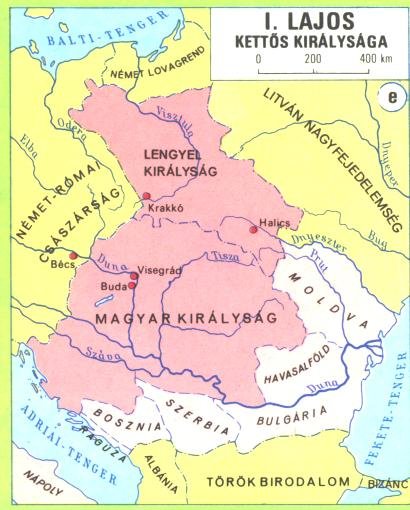
The Kingdom of Lajos the Great
After the death of Mária, her husband Zsigmond of Luxemburg (1396-1437) was elected to be the king. Under his leadership there was some significant construction, especially of fortresses, but his true interest lay in the expansion of his power over ever-greater territories, and in that endeavor he was successful. He became the king of Bohemia and even the Emperor of the German-Roman Empire. He succeeded in defeating the Hussites, but he wasn’t so successful against the Turks. Although, there were excellent opportunities in 1398 and 1399 to force the Turks out of Europe, when their Empire was attacked from the east by the forces of Timur Lenk. Zsigmond succeeded in gaining great power in the internal affairs of the Roman Catholic Church, and those privileges remained until the end of the Hungarian Kingdom.
Albert Habsburg followed Zsigmond, but he died in 1439. After his death a power struggle erupted for the throne. The rich and powerful members of the aristocracy quarreled amongst themselves and they elected weak kings in order that the kings would serve them instead of the country. This was the time when strong leadership was needed, because the Ottoman Turks had already broken into Hungary proper. Out of this internal strife, the figure of a great military leader, János Hunyadi, emerged as the savior of the country. In 1446 he was elected to be the Governor of Hungary, with most of the king's authority delegated to him. He resigned this post in 1452, so he could take firm control of the military. King László V appointed him to be General of the Armies and he became the caretaker of the King's treasury as well.
In June of 1456 the Turkish sultan, Mohammed II, marched his armies to capture Nándorfehérvár (today's Belgrade) on his way to conquer Europe. With a massive army of some 150,000 foot soldiers, 300 cannons, and 200 ships, the city was encircled. The defenders, under the leadership of Mihály Szilágyi (the brother-in-law of Hunyadi), numbered only around 6,000. With the help of some 12,000 men, János Hunyadi and John Capistrano (a Franciscan monk) broke through the encirclement and established contact with the defenders as more supplies and an additional 2,000 reinforcements were sent in. The Pope ordered prayers and church bells to ring at noon for victory. By this time, Hunyadi's forces in and outside of the city numbered about 25,000 strong. The Turks launched their final attack on the 21st of July. Hunyadi, Szilágyi and Capistrano were able to beat them back, launching a counterattack and destroying the Turkish forces the very next day. The ringing of the church bell at noon is still a reminder of this victory. With this victory, Europe was saved from Turkish invasion; however, a plague broke out as a result of the decomposing bodies in the great summer heat. In three weeks, Hunyadi fell victim to the plague. Kings, leaders, and soldiers of Europe paid tribute to Hunyadi; even Muhammed II sent his condolences remarking, "The world has never seen such a man". About two months later, Capistrano also fell victim to the plague. He became a saint of the Roman Catholic Church; in California, Capistrano Beach is named after him.
The enemies of the Hunyadis, under the leadership of Cillei and Garai, used this opportunity to capture Hunyadi's sons, László and Mátyás. They beheaded László and kept Mátyás in captivity. The weak King László V., fearing for his life, escaped to Vienna (and then to Prague) taking Mátyás with him as a hostage. The friends of the Hunyadis took great exception to this, and Szilágyi paid 40,000 pieces of gold in ransom to gain his release.
Mátyás was elected to the throne in 1458 and became one of Hungary's wisest, most powerful, and most beloved rulers. Mátyás enacted laws that were evenhanded and just. There are numerous legends surrounding him; there is even a saying often repeated today: "Mátyás the Just died - and so did justice." He set up a well-trained Black Army (a mercenary force whose uniforms were black) for the defense of the country. His campaign against the Turks was as successful as his father's had been. However, more than once, he had to buy peace from the Turks in order to defend the country from the West and keep the internal enemies in check. Mátyás was one of the most learned rulers of his time, his library was famous throughout Europe. He ran a splendid court, which was the envy of Europe, visited by scholars and scientists from all over the continent. He died – probably at the hands of an assassin – at the age of 50, in 1490. He was the last great and powerful King of Hungary. The anarchy among the aristocracy now re-emerged, worsening the internal conditions to the point that in 1541 the Turks marched into Buda and took over the city without any resistance.
The explanation that the demise of the powerful Hungarian Kingdom had resulted from the defeat at the hands of the Turks in 1526 at Mohács is inaccurate. That battle took place on August 29, 1526, King Lajos II losing his life also. The victorious Turkish troops wandered all over the country to loot and pillage. They stumbled into heavy local resistance and by mid-October had left the country; the Turks did not keep Hungary under occupation, as the Soviets did in 1945.
It can be stated, unequivocally, that the selfish aristocracy caused the demise of Hungary’s greatness. In fairness, the point must be made that selfishness is not unique to the Hungarian aristocracy. It is the result of material riches and feeble human character, demonstrable in the history of any nation or country. In the case of Hungary, it became disastrous; during this time of grave external danger no ironhanded leaders emerged (such as the Hunyadis had earlier) to save and protect the country. Hungary at that time had the economic and military power to stand up to the Turks, especially, if she did not have to defend herself from the Western threats at the same time. Hungary has an important geographic location, dividing Europe into the western and eastern civilizations. Culturally, Hungary had broken away from the East half a millennium earlier, yet was never fully accepted by the West. In her struggle for survival, Hungary defended not only herself from eastern invasions, but also defended the West. The West watched this struggle indifferently, at times seizing the opportunity and launching an attack on her.
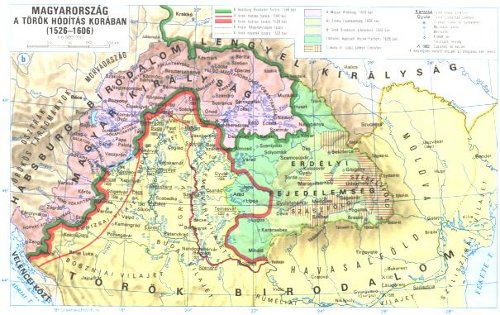
By the Turkish invasion, the Hungarian Kingdom was divided into three parts
The following is an excellent case in point, an illustration as to what it takes to destroy a nation or a great power, any nation or any great power. After the tragic battle at Mohács, on the 10th of November, a group of aristocrats gathered at Székesfehérvár and elected János Szapolyai (1526-1540) to the throne. The aristocrats opposing Szapolyai gathered at Pozsony on the 16th of December electing the Habsburg Prince Ferdinand (1526-1564) to be King. (This event laid the foundation for the Habsburgs to keep the Hungarian crown for the next 400 years.) The primary goal of these two kings for the next thirteen years was to gain the upper hand or, if possible, destroy the other. In this struggle, Szapolyai more than once acquired the help of the Turkish sultan, Suleiman II. Ferdinand, of course, received help from Austria and from the West. In 1538, they finally made peace. Szapolyai agreed that after his death Ferdinand should become the sole king. Just as had happened with Emperor Manuel many years earlier, a son was born to Szapolyai two weeks before his death and he ordered his followers to elect the baby to be the new king. Suleiman was made guardian of the Baby King. On August 29, 1541, on the very day of the 15th anniversary of Mohács, Suleiman marched into Buda under the pretense of protecting the interest of the Baby King, and stayed.
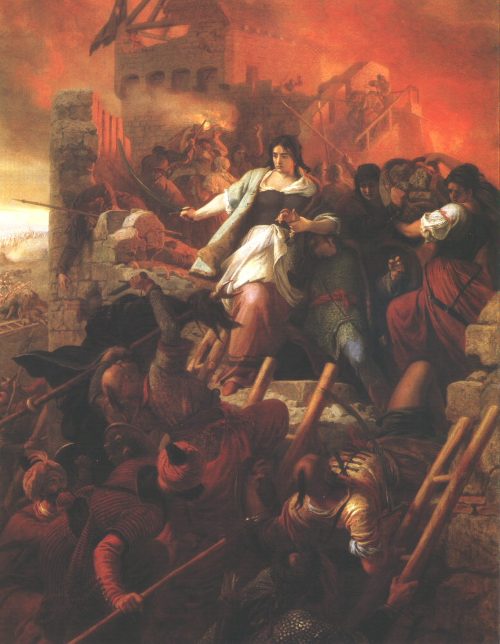
The Heroines of Eger (by Bertalan Székely)
The advancing Turkish armies occupied the Great-Plain and most of Dunántúl (western Hungary). Transylvania had purchased peace from the Sultan, thereby enabling it to keep its internal "independence". A narrow strip of western Hungary, along with the northern Carpathians, remained under Hungarian, that is, Habsburg rule. This offered an excellent opportunity to the Habsburg kings to gain absolute power and negate the rights guaranteed by the Aranybulla. In this effort, they didn’t quite succeed, because the aristocracy stood up to the king. The following 150 years were to be an era of valiant struggle to free the country from Turkish occupation and Habsburg domination. Take for example the heroines of Eger or the defenders of Szigetvár. In 1552, the women of Eger fought alongside their men against overwhelming odds. Some fought with swords in their hands; others threw rocks or dumped boiling water on the invaders. Their efforts led to an incredible victory over the besieging Turks.
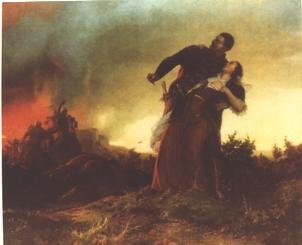
A Hungarian officer killing his wife (by Bertalan Székely)
Sadly, the heroes of Szigetvár weren't quite so lucky. In 1566, some 2,500 Hungarians and Croatians defended their city surrounded by some 90,000 Turks. In attack after attack, they repelled the Turkish charges, inflicting heavy casualties upon them. Some 25,000 Turks died at Szigetvár, but because of their large numbers, they persisted in their attack on the city. With the number of defenders dwindling to about three hundred, their supplies having been used up; further resistance looked hopeless. The wives and daughters of the officers decided that they would rather die than fall into Turkish hands and be dragged into slavery. The husbands killed their wives; fathers killed their daughters before the final counterattack. Count Miklós Zrinyi gathered his loyal troops and led the last brave and furious charge; all but three of them died heroes' deaths. However, the Hungarians had to defend the remnants of their country against the Habsburgs also. In 1685 Ilona Zrinyi was forced to defend the fortress of Munkács (in Ukraine today) against the Austrian general Caraffa. After over two years of heroic struggle, her supplies were exhausted. She negotiated an agreement with the general, who was reasonable, but she had to give up the fortress. Though encircled, Transylvania enjoyed some internal stability. However, at times, István Bocskai (1604-1606, in the first armed clash with the Habsburgs) and Gábor Bethlen (1613-1629) were forced to take up arms against the Habsburg absolutism. History was made in 1568 when the Diet (Congress) of Torda (Transylvania) declared religious freedom to Protestants and Unitarians along with the Roman Catholics, giving each individual the right to choose his or her own religion, further proving that Hungary was at the forefront of social development in Europe. At the very least, part of the country was able to exercise its domestic freedom.
The territory under the Turkish occupation was significantly depopulated and the infrastructure destroyed. Many men and women alike were carried off to slavery or inducted into the Turkish Army, which weakened the country’s resistance. In 1683, the Turks launched an attack on Vienna, but they were repelled. This was an indication that the fearsome enemy was weakening. In 1686, Buda was freed from Turkish occupation. Emperor Leopold, the Habsburg king of Hungary declared that every regained territory was his own domain. He offered amnesty to those who laid down their arms and swore loyalty to him, but he negated many clauses of the Aranybulla, most importantly the one that guaranteed the right of defense against an overzealous king. He also made the newly loyal aristocracy accept that only a Habsburg could be elected to the Hungarian throne. Leopold returned the property to those who accepted these conditions. Many did not. The Turks were finally forced out of Hungary and a peace treaty was signed in 1699 at Karlóca.
The Battle Flag of Rákóczi II.
Only five years later the anti-Hungarian policy carried out by the Habsburgs resulted in a War of Independence led by Count Ferenc Rákóczi II in 1704. After the Turks had been expelled, the Hungarians moved back to reclaim their former properties. The Habsburg armies chased them off and brought in foreign settlers to take their place. This became the basis for the Treaty of Versailles (Trianon) in 1920. It would be unfair to say that the Habsburgs alone were responsible for the dismemberment of Hungary, as the Hungarian nobility had done more than its share in this regard. In Transylvania, they brought in large numbers of Rumanians for cheap labor. The grandfather of Rákóczi II, György Rákóczi, translated the Bible into Rumanian, so they could be educated and cultured, and of course the pay-off came in the first quarter of the XX century. It is ironic that after the War of Independence was lost in 1711 (the peace treaty was signed at Szatmár), Rákóczi found exile in Turkey where he died and was buried. His remains were brought back to Hungary in 1906 and reburied at Cathedral of Kassa (Kosice), the city that belongs to Slovakia today. One of his military leaders, Count Miklós Bercsényi, went to France and organized the French cavalry into an effective fighting force. Out of this unit came Colonel Mihály Kováts, who did the same to the American cavalry. He died at Charleston in the American War of Independence in 1779, leading the cavalry charge against the British. Interestingly enough, another Hungarian cavalryman, Captain Károly Zágonyi, fought and led the first victorious battle on the Union side of the American Civil War at Springfield, Missouri in 1861.
The Turkish conquest and Habsburg domination could not have come at a worse time in Hungarian history. The Renaissance renewed and revitalized European cultural and spiritual life. Universities and colleges had been built throughout Europe, while Hungary in the XV and XVI centuries spent her blood and economic fortune on defense against the Turks. Afterward came 150 years of Turkish occupation resulting in one third of the country being ravaged and depopulated. As devastating as the Turkish occupation and Habsburg domination were, coupled with internal strife and discord, these were not the only reasons that Hungary could not regain her independence. In the early or mid-1700's, a new social order was in the making all across Europe. Beginning with the French revolution of 1789, this new order became the guiding force in social and national life as it swept away the old. In the old order, the guiding force was loyalty to the ruler. In the new social order, the nation was elevated to an idealistic high. In light of this new patriotic ideal, the western nations rewrote their history books in service to the nation, and this ideal became the dominant force guiding their society. Relentlessly and mercilessly it rolled over ethnic groups like a steamroller and, in the West, most minorities disappeared overnight. In Hungary this new nationalistic idea could not take hold, because of foreign domination. It had to wait until the 1820’s when Count István Széchenyi found the way to get around the Habsburg rulers. His sound economic and cultural policies laid the foundation for the new social order. The Széchenyis founded the Hungarian National Museum, the Széchenyi Library, the Hungarian Academy of Science, the first permanent bridge across the River Danube, which linked Pest and Buda, the lock on the Danube that made it navigable, and so on. But the War for National Independence of 1848-49, led by Lajos Kossuth, was put down and with it, all social and economic advancement went up in flames. Therefore, a true national identity never had the chance to take hold in the minds and hearts of Hungarians as a firm social guiding force. As a result, Hungarians never had an opportunity to write their own history in the best interest of their very own nation. It is this written history in which the information is accumulated that is necessary to build national self-respect and a sound future. If the written history is negative and demeaning, it will destroy the spirit of a nation. Any nation.

Count István Széchenyi is one of the greatest Hungarians who ever lived.
In 1840 Hungarian become the official language of the country.
One of the major problems Europe faced in the early 19th century was the question of equal taxation. The aristocracy paid no taxes (or very little) and because of this, a heavy burden was placed on the people of the lower echelon as well as on the serfs. It created an internal unrest and revolution was in the making. Western countries encountered similar situations. In early 1848, revolution broke out in Paris; Vienna shortly followed its lead. Hungary was also ready for a revolution. The aristocracy was certainly under great social pressure, but nonetheless, on the morning of March 15, 1848 the Hungarian aristocracy became the only upper class in history to give up its privileges of its own free will. With this step they averted revolution and allowed the country to turn its attention and resources to the War of Independence. The war was going well for the Hungarians, but when the Habsburgs were able to reach an agreement with the Russian czar in 1849 (sending some 200 thousand fresh eastern troops to the battlefields) the outcome was determined. The war was lost and the peace treaty was signed at Világos, which was followed by the seventeen years of terror by the Bach-regime from Vienna. The Prime Minister of Hungary and thirteen generals were executed, hundreds were jailed and exiled, including Lajos Kossuth, the leader of the heroic struggle.
Finally, in 1867, an agreement was signed between the Habsburgs and Hungary that guaranteed internal independence to the country. As a result the Austrian-Hungarian Monarchy was born. During and after the War of Independence, an oligarchy seized most of the economic wealth of the country; working from behind the scenes, it applied heavy pressure on the government, preventing it from solving the deep-rooted national problems.
The First World War broke out in 1914 and was blamed on Hungary. This was a malicious fabrication. One has to know that Hungary at this time was part of the Austrian-Hungarian Monarchy, and had no foreign policy of her own. The Prime Minister, Count István Tisza, was the only Hungarian member of the Monarchy's government, and he was the only one to oppose declaring war on the Serbs after the assassination of Archduke Ferdinand at Sarajevo. Nevertheless he was forced to do just that in two weeks time. The war ended in 1918 in armistice, which was signed between Italy and the Austrian-Hungarian Monarchy on the 3rd of November. Up until that day not a single enemy soldier set foot on Hungarian soil; however, the French did not recognize the armistice just signed, and kept moving their army toward Hungary, encouraging the Czechs, the Romanians and the Serbs to do the same. Anti-Hungarian elements seized the government, which called upon the Hungarian troops to lay down their arms wherever they were. Most of the Hungarian army disbanded and the remaining ones were totally disorganized. Hungary was on the losing side and became occupied by enemy armies.
In 1920 the "Peace" Treaty of Versailles (Known to Hungarians as the Treaty of Trianon) was forced upon Hungary. As a result, historical Hungary was dismembered. The Austro-Hungarian Monarchy and the Habsburg Dynasty were also disbanded. This was done in the "noble" cause of "self-determination". The newly drawn borders placed 3.5 million Hungarians under foreign rule overnight. Of that number, over a million resided along the new borders. In these areas, the population was almost 100% Hungarian. There were 2 million Hungarians in the expanded Rumania, 1 million in the newly created Czechoslovakia and ½ million in the also newly created Yugoslavia, amongst other nationalities. Therefore, Rumania and the newly created countries were just as diverse ethnically as Historic Hungary was. According to the "Peace" Treaty of Trianon, the affected people should have decided by referendum which country they wanted to belong to. This was done in only one such case: that of Sopron and the surrounding villages, the westernmost city in modern-day Hungary. Originally, Sopron and its vicinity had been given to Austria, but mostly young people organized an armed resistance, and they were unwilling to put down their arms until the referendum was voted on in 1923. The people voted overwhelmingly to remain with Hungary. Because of this result, no other village or city was given the chance for self-determination. So much for the high-sounding principles and noble causes put forth by the "Peace" Treaty.
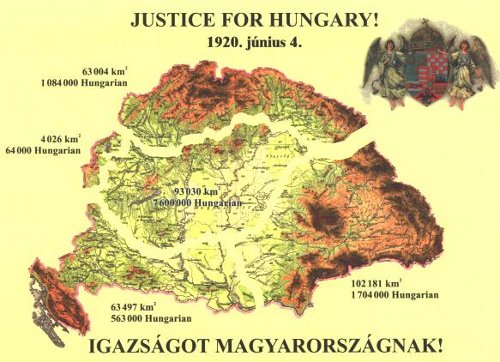
The dismembered Hungary by the Peace Treaty of 1920 and 1947.
The dismemberment of the country shocked the nation to the depths of her soul. A vibrant spiritual and cultural renewal began to grow out of the ashes. Hungary wanted to live again. In the late 1930's and the early 1940's, Hungary regained some of her lost territories. This Renaissance, however, didn't last long. The Second World War buried it. The war was followed by Soviet occupation and Communist dictatorship. In the second "Peace" Treaty of 1947, this time in Paris, Hungary lost the regained territories and three more Hungarian villages on the right bank of the Danube; Slovaks wanted a foothold in the city of Pozsony (Bratislava). The nation rose once more in 1956, but it was brutally suppressed. Thousands died, some 200 thousand Hungarians escaped to the west, tens of thousands were deported to the Soviet Union, and thousands were jailed and executed in Hungary. Hungarians lost all hope and then turned inward. Ever greater numbers of women sought abortion, which was free under the Communist government, (and still is) and as a result, the Hungarian population began to decline in 1981 and has been declining ever since.
It can be safely stated that Hungary, and the Hungarian people themselves, have never been in such grave danger in their vast history as they are today. No matter how devastating were the conditions of the past, the birth rate had never dropped under the replacement rate; the people and the country survived. Unfortunately, more than forty years of Communist rule extinguished the last glimmering flame of national self-respect. Astonishingly, perhaps all has not been lost; twelve years after the demise of communism, some awakening can be seen in the faces of the youth of this great and ancient nation, Hungary.

